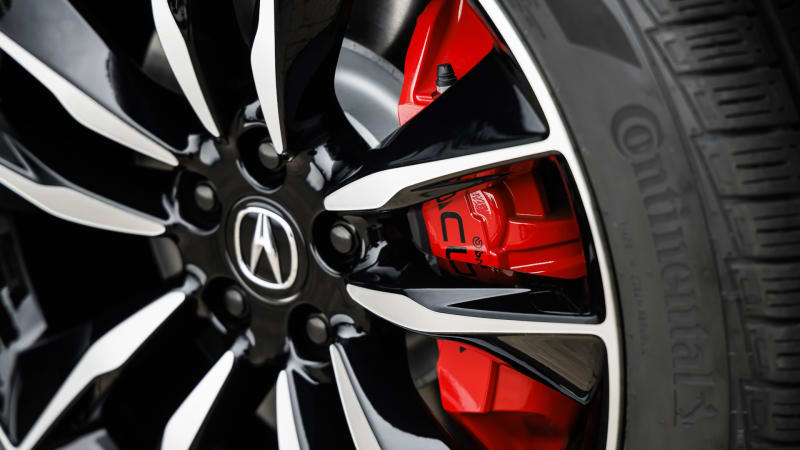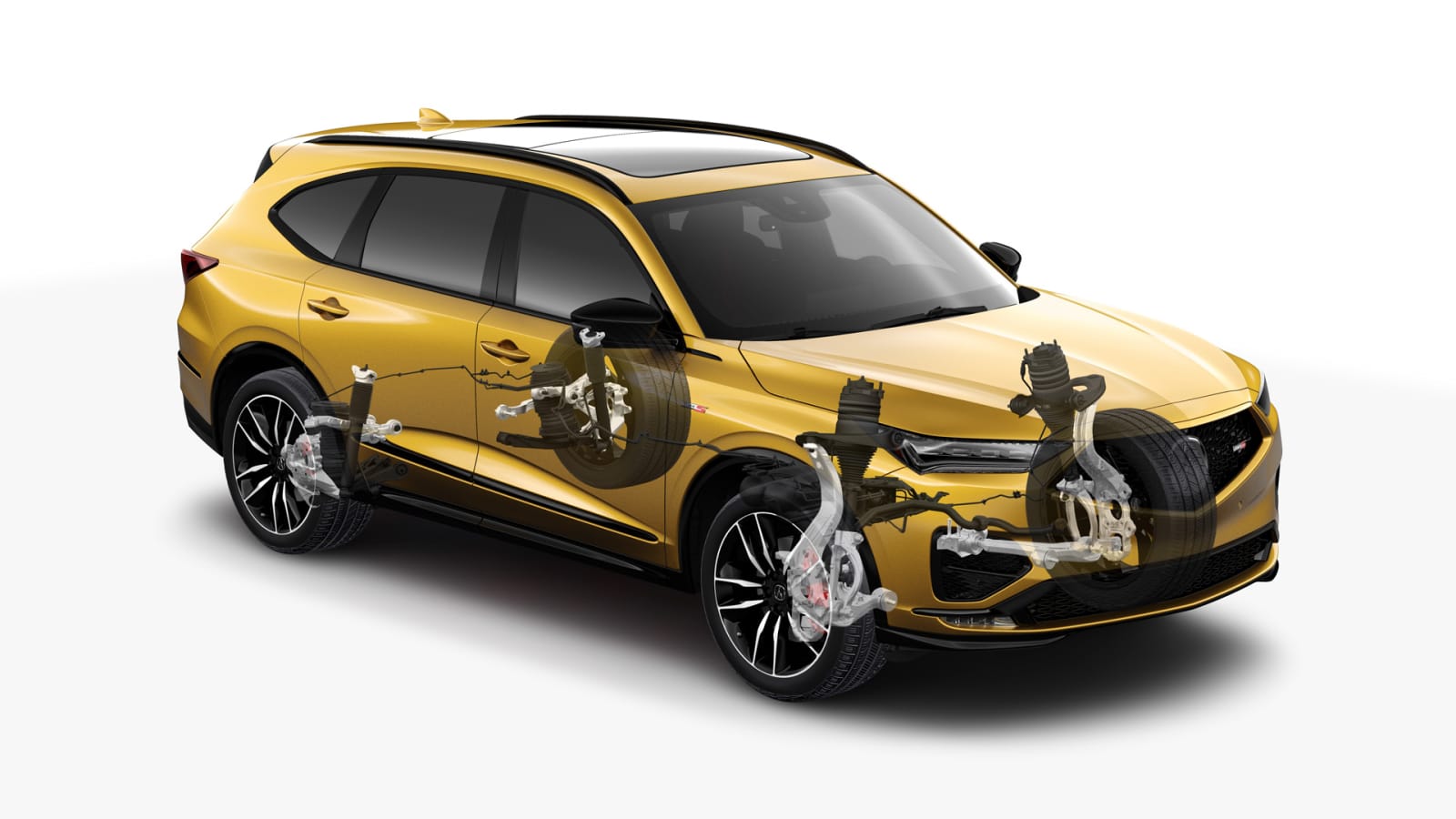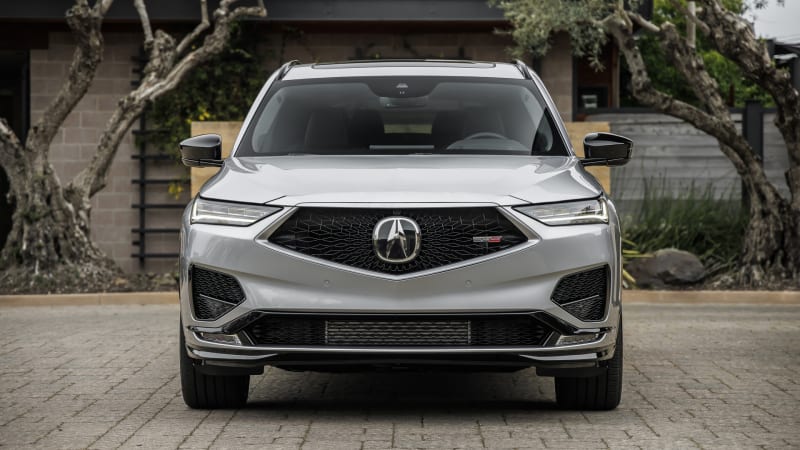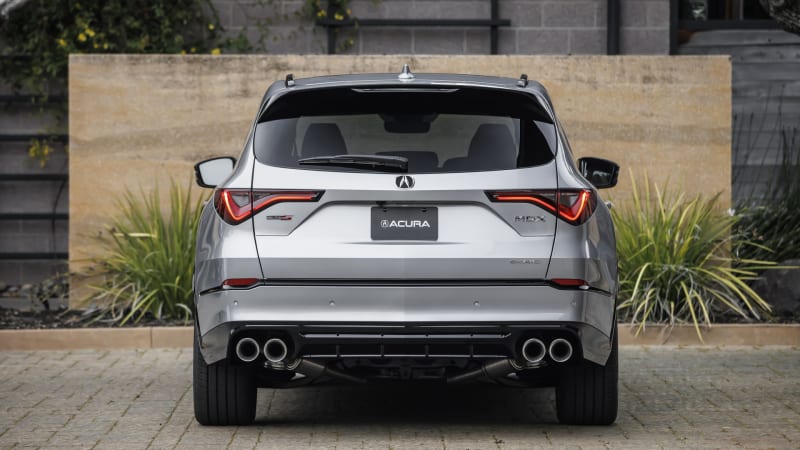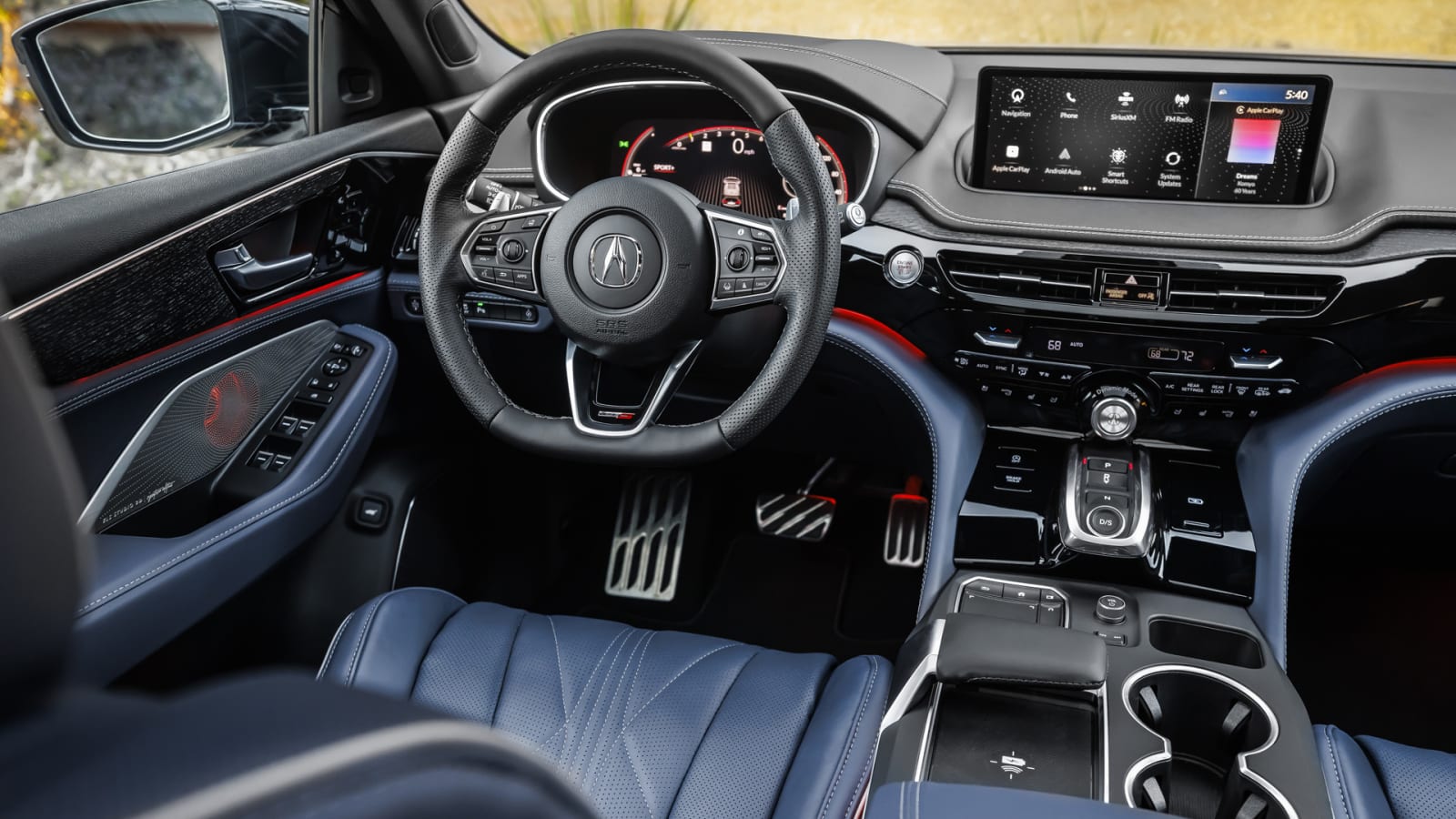NAPA, Calif. — First things first: The 2022 Acura MDX Type S is not the Honda premium brand’s attempt to create a BMW X5M. Then again, at $67,745, it comes in 30 grand under the storming German SUV. So while the Type S carries the imprimatur of high performance, it is priced more in line with the entry-level BMW X5 xDrive40i, plus the Audi Q7 55 TFSI and Mercedes GLE 450 4Matic that have upgrade engines but fall well short of being considered high-performance models.
Acura makes a more convincing showing of it with the Type S, but you still get what you pay for – and sometimes paying less is OK. What Acura has created is an upgraded midsized SUV that gives sufficient sportiness to enthusiastic drivers, without clamping down on handling and braking harder than Thanos’ gauntlet.
Here’s what to tell your friends at the bar: Acura ripped out the stock 3.5-liter V6 for a 3.0-liter sequential twin-scroll turbo that adds 65 horsepower (to 355) and 87 pound-feet of torque (to 354), and beefed up the 10-speed automatic transmission with a new torque converter, stronger gears and improved clutches to handle the increased power. It was also reprogrammed for improved response, especially in the new, Type S-exclusive Sport+ mode. Brake upgrades include four-piston 14.3-inch Brembos up front. And Acura claims its first-ever air suspension – courtesy of supplier Continental – delivers both improved ride and dynamic performance.
What does that mean when you’re actually behind the wheel? On a rainy day in Napa, California, marked with intermittent drizzle that turned the narrow two-lane roads greasy and slithery, the MDX Type S revealed its beefy size on occasion but also comported itself confidently.
Most confident on corners marked “35 mph” or above, the Type S felt a bit bogged down in slower corners – especially when getting on the gas too early. Acura claims that its torque-vectoring Super Handling All-Wheel Drive will help round off corners when accelerating out of an apex, but the laws of physics and slippery roads still apply. Hitting the gas earlier in a wet corner’s apex can result in some bonus wheel slippage and mini-rotations thanks to SH-AWD, which is great fun if you are expecting it from this 4,741-pound beast.
Due to the wet conditions, it was difficult to get a sense of the additional power of the new Ohio-built turbo engine, or how the strengthened transmission displayed its quicker upshift and downshift times (while keeping the gear ratios the same). But the aural sensations were indeed different – acceleration is initially marked by the gentle whoosh of the turbos spooling up, followed by a hard snarl from the 3.0-liter engine. While the Type S returns an EPA-estimated 17 mpg city, 21 mpg highway and 19 mpg combined (versus 21 mpg combined in the base MDX), our drive route emphasized performance – with no highway driving to sample its variable cylinder management – and as a result, our test model’s trip computer reported an average of only 13.3 mpg over a four-hour road loop.
Drive modes in the Type S default to Normal mode with each startup, and the standard suspension compliance feels similar to Sport mode in the base MDX. Acura says the electric power steering effort is stiffer by about 20% – but it feels sportier than that, as the standard MDX’s steering is so light and overboosted. To change among the myriad driving modes for the engine, transmission, and air suspension, the driver twists a large knob in the middle of the dashboard’s center stack (as one does in the base MDX and other Acuras). But if you want a more aggressive shift pattern without moving the suspension into a sportier setting, pressing the D/S button in the gear selector array accomplishes this task.
A big plus for the MDX Type S are the brakes. Normally, adding sport-style brakes like these 14.3-inch front Brembos results in hair-trigger responsiveness that transforms boulevard traffic and parking lots into a jarring, choppy affair. Not so here. The Type S also gains an electro-servo braking system, derived from the NSX, where applying the brake effectively sends an electronic signal to a computer, which then precisely applies hydraulic pressure to the calipers. The result is a brake pedal that is very easy to modulate – whether it’s to firmly apply increased braking force as you approach a corner and want to keep this big SUV in balance, or if you have to stab the brakes hard because a large truck has crossed the center yellow line mid-corner and it’s coming right at you. Anecdotal testing on the wet roads showed the ABS calibration to be well sorted.
But it’s the air suspension that’s truly magical, delivering on Acura’s promise of improved handling and a more compliant ride. Typically, the over-firm tuning of German sport models’ suspension is a dentist’s delight. But the MDX Type S maintains a civility where you can feel the subtlety of what’s going on underneath your tires – in terms of road ripples, frost heaves, and the like – but it doesn’t beat you up. There is an elegance to the ride even in the sportiest setting. Yes, it means sacrificing some cornering precision and speed, but kudos to the Acura (and Continental) engineers for realizing this brand’s customers aren’t looking for a seven-seat racecar.
(An aside: About the seven-occupant reference. Just like the base model, the Type S will fit seven humans in a pinch. Just know the third-row is definitely a children-only affair.)
The air suspension also boasts adaptive dampers, auto load levelling, dynamic ride height, and a Lift drive mode that raises the right height by an additional 2 inches at speeds up to 37 mph. Ground clearance therefore ranges from 6.7 inches up to 9.4 – that ought to get you through the snow drifts to your chalet.
The Type S also features self-sealing high-performance tires mounted on 21-inch wheels. Note, these are not run-flats. These 275/40R21 Continental tires can actually seal leaks and other insults in the treads up to 5 mm. Of course, that means there is not a spare tire. That allows more room in the back for gear, and also for the battery that moves from the engine bay to the cargo area to help with weight distribution.
MDX Type S top, standard MDX bottom
Visually, the Type S gets different front-end styling, including a more aggressive spoiler and an altered grille that lets more air under the hood. Black trim is added throughout, with the Advance Package gaining even more around the wheel arches and lower body trim. The quad tailpipes are not only unique to the Type S, but so is the entire active exhaust system, adapted from the NSX, which opens an additional flap for increased noise at either 4,750 rpm in Comfort, Normal and Sport modes, or 3,250 rpm in Sport+.
Inside, the Type S gains a flat-bottom steering wheel and Milano leather seats available in Red, Ebony or Orchid (a light creme) with black Ultrasuede inserts. The Advance Package swaps out those inserts for full leather featuring a unique stitch pattern and the additional option of Azurite Blue, pictured here. It also adds front seat massage, an Acura first, with nine modes and three levels of intensity for long drives.
For audiophiles, the base Type S offers an ELS 3D sound system with 16 speakers, 16 channels, and 710 watts of power, while the $73,095 Type S with Advance package boasts an ELS system with 25 speakers, 22 channels and 1,000 watts. That’ll rock you like a hurricane.
Unfortunately, the Type S has the same infotainment system as every other MDX, which uses a distracting, overcomplicated, painstaking-to-learn touchpad system to activate most systems (though at least one Autoblog editor has learned to tolerate it). Climate controls are manipulated with Chiclet-sized buttons with symbols that are all but illegible due to their high-gloss piano-black surfaces.
Other glitches in our test vehicle: The backup camera was blurry to the point of unusable in the wet despite a standard lens washer, and the reverse-parking overlay lines on the video screen were mistakenly offset by about a foot to the right. The lane-keeping assist system set off several false alarms for non-transgressions, while the forward-collision warning system alerted the driver about cars that had already well cleared the lane. This would be consistent with other Acuras and Hondas.
Acura has made better-than-expected success with the MDX over the years. Since its introduction for 2001, Acura has sold more than 1 million units. Acura claims the only other luxury-badged nameplates with such a sales record are the BMW 3 Series, Mercedes-Benz E-Class, and Lexus ES and RX. That’s some strong company. Acura expects between 10-15% of MDX sales to be Type S. Then again, that percentage was expected for the TLX, and its Type S is above 25% presently.
At its heart, the MDX Type S is a seven-seat SUV with more than a dash of extra sportiness – something Acura insists is core to its brand promise. What remains to be seen is whether the recipe applied to Acura’s TLX and flagship NSX sports car can extend successfully to a larger mall crawler. It works for the German brands’ SUVs, but the voice of the customer will bear out whether it does for Acura.
Related Video:
Source: www.autoblog.com


